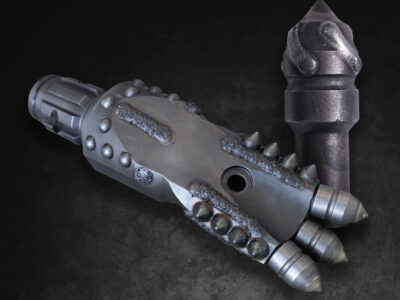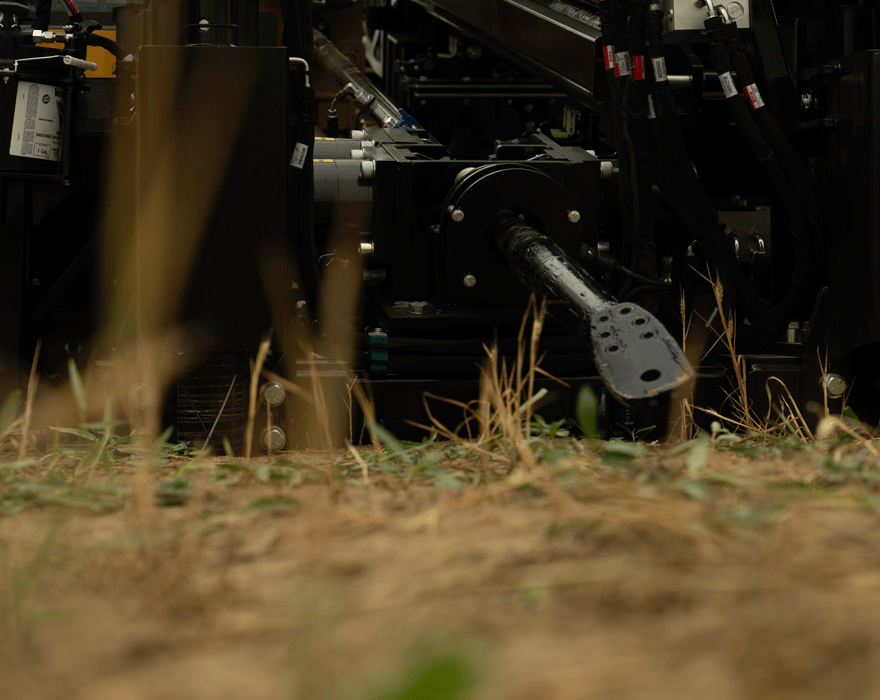Hardfacing extends component life in high-wear environments, allowing tools to retain their shape for improved performance while minimizing the maintenance associated with wear part replacement. Tungsten carbide hardfacing has been the time-proven method for adding wear resistance to drill bits, housings, reamers and other ground-engaging tools. But there is a new emerging process — laser cladding.
Laser cladding is a refined process, similar to welding, that uses a high-intensity laser on a part to create a metal puddle on the base material. A nozzle evenly deposits carbide powder into that puddle. This creates a metallurgical bond. The treated area exhibits wear resistance similar to tungsten carbide hardfacing.
Tungsten carbide hardfacing vs. laser cladding
So is laser cladding going to replace tungsten carbide hardfacing? No. There are advantages to each process and the application determines the best choice.
Comparing carbide hardfacing to laser cladding is like comparing a sprinkled donut to a glazed donut. The tungsten carbide hardfacing is similar to the sprinkled donut. The hardfacing treatment is on top of the part and some is embedded into it. Laser cladding is like the glazed donut with an even distribution of wear protection across the part, but it’s less visibly evident.
Laser cladding produces a very uniform but thin surface area that can have a very high concentration of carbide. The hardfacing is embedded within the part. This contrasts with the less uniform tungsten carbide hardfacing where the welding process with the addition of the carbide grit and weld wire can create a larger protruding surface area of wear protection.
Application determines best solution
The type of wear the part experiences during operation — impact or sliding wear — helps determine the correct approach for applying a wear-resistant hardfacing.
“Laser cladding has its biggest advantages in heat input and sliding wear,” said Brock Moore, Vermeer design engineer.
High precision and control of the coating process leave a relatively smooth finished surface. Introducing minimal heat during the process allows the components to maintain their shape and structural integrity. This process is ideal for parts with thin sections or complex geometries that are more heat sensitive.
The treated area will generally exhibit a lower volume of hardfacing, although there will be a high concentration of carbide. The tungsten carbide process allows greater buildup through the addition of the carbide grit and weld wire for greater wear surface area. In addition, tungsten carbide can be applied using a MIG welding process without sophisticated equipment and skilled operators required for the laser-cladding process.
Tungsten carbide hardfacing is ideal where you want large buildups to extend wear life or the part is subject to high impacts.
“In the future, I see laser cladding being used in areas where we have traditionally avoided adding hardfacing, such as slide wear applications and applications where it is advantageous to maintain tight part geometry. A possible application is the precise rifling pattern on conical teeth,” said Moore. “But I still see tungsten carbide hardfacing being used in areas where it is tried and true. It provides greater performance in impact wear situations, and it can be built up with multiple weld passes.”
For more information on drill bits, contact your local Vermeer dealer or visit borestore.com.
Vermeer Corporation reserves the right to make changes in engineering, design and specifications; add improvements; or discontinue manufacturing at any time without notice or obligation. Equipment shown is for illustrative purposes only and may display optional accessories or components specific to their global region. Please contact your local Vermeer dealer for more information on machine specifications.
Vermeer, the Vermeer logo and Equipped to Do More are trademarks of Vermeer Manufacturing Company in the U.S. and/or other countries.
© 2024 Vermeer Corporation. All Rights Reserved

